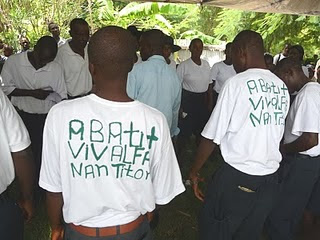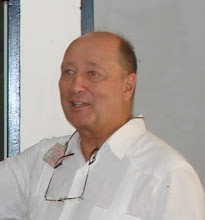 My appreciation for everything we have access to here in the United States grew exponentially since my visit to Haiti. It amazes how abundant our resources are, and it troubles me greatly. We waste too much of everything here; but the one thing that now troubles me most of all is our waste of food. While at HAS I worked with the children and families in the Annex (the malnutrition unit) whose major challenge has been to get enough food to eat.
My appreciation for everything we have access to here in the United States grew exponentially since my visit to Haiti. It amazes how abundant our resources are, and it troubles me greatly. We waste too much of everything here; but the one thing that now troubles me most of all is our waste of food. While at HAS I worked with the children and families in the Annex (the malnutrition unit) whose major challenge has been to get enough food to eat. While at HAS, I worked with the kids and families in the Nutrition Annex. I visited and painted with them many afternoons during my stay. I noticed how closed off and sad all the patients and their families were. After only a few minutes of interaction, they opened up and started laughing and smiling.
While at HAS, I worked with the kids and families in the Nutrition Annex. I visited and painted with them many afternoons during my stay. I noticed how closed off and sad all the patients and their families were. After only a few minutes of interaction, they opened up and started laughing and smiling. I became very curious as to how these children became malnourished in the first place. The hospital’s community-based workers, Animatrices, had collected data to find which areas have the highest risk households for having a malnourished child. I helped to enter the data from these surveys into a register, and once the data was compiled and the areas with the most risk factors identified, we headed up to the mountains (where there were the most household with high risk factors) to see where the children who came to the Annex came from.
 We went to house after house with four or five risk factors. The established risk factors are simple; If a family has a metal roof rather than thatched they are at less of a risk. If they have a latrine they are at less a risk then those without. If the family uses a method of family planning then they are at less of a risk of having a malnourished child. If they cook on some sort of elevated “stove” they are at less of a risk then if they cook on three stones on the ground. If a family has a pump near their house they are much better off then if they have to walk miles to a stream and if they have a filtration device for the water their children are less likely to be mal-nourished.
We went to house after house with four or five risk factors. The established risk factors are simple; If a family has a metal roof rather than thatched they are at less of a risk. If they have a latrine they are at less a risk then those without. If the family uses a method of family planning then they are at less of a risk of having a malnourished child. If they cook on some sort of elevated “stove” they are at less of a risk then if they cook on three stones on the ground. If a family has a pump near their house they are much better off then if they have to walk miles to a stream and if they have a filtration device for the water their children are less likely to be mal-nourished. At the houses with high risk factors, we found malnourished kids by measuring their arm circumference (less then 12cm indicates a malnourished child. 12cm shows the child needs to be watched carefully and over 12cm means they are OK).
 |
| Robin Brody |
On the positive side not every high-risk home had a malnourished child. In the houses with malnourished children we gave the families pre-packaged bags of dried rice, bean, vegetables and vitamins in hopes that the children could gain a little weight each week, and the other children could be kept from becoming malnourished.
It was fascinating and devastating to see the relationship between the high-risk factor houses and the children who had dipped to low and ended up in the Annex at HAS. The experience made me incredibly grateful and eager to do something more to help!







